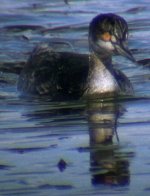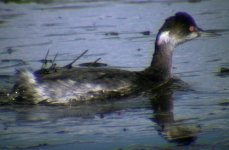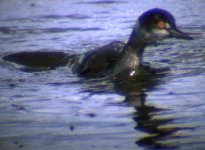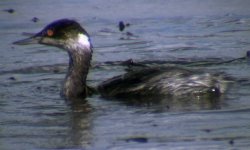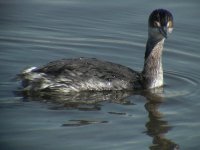David Ellsworth
Well-known member
I videoed this grebe today (well, yesterday). What intrigued me at the time is that I hadn't seen this particular diving behavior before; normally when a grebe dives, I can't see it or track it at all until it surfaces somewhere else, seemingly randomly. But this grebe was diving in shallow water and I was able to follow the flurry of water and catch the grebe on camera the moment it surfaced. There was lots of vegetable matter which was the grebe was getting caught in and repeatedly having to shake off.
I did not notice the anomaly until I looked at the still photos (I haven't transferred the video yet). It sure looks like an Eared Grebe in most respects (and I assumed the same while I was filming it), but it has distinct white spots over its lores like a Horned Grebe. The bizarre thing is that these spots are very dull looking from a sideways view, almost black, but when the grebe angles forward they became bright. In an Eared Grebe photo search I have only either seen no spots or very dull spots.
Is this in fact an Eared Grebe? If so how can the spots be explained? The location is San Pedro, California.
I did not notice the anomaly until I looked at the still photos (I haven't transferred the video yet). It sure looks like an Eared Grebe in most respects (and I assumed the same while I was filming it), but it has distinct white spots over its lores like a Horned Grebe. The bizarre thing is that these spots are very dull looking from a sideways view, almost black, but when the grebe angles forward they became bright. In an Eared Grebe photo search I have only either seen no spots or very dull spots.
Is this in fact an Eared Grebe? If so how can the spots be explained? The location is San Pedro, California.




